While many might think of Arizona as just a big desert in the United States, home to the Grand Canyon and Hoover Dam, it has a surprisingly diverse landscape ranging from mountain canyons to woodlands and to the familiar arid deserts. And fortunately, this diversity has also made Arizona the preferred habitat for many magnificent hummingbird species.
Hummers’ migration patterns carry them all over North and Central America, all the way down to South America, leading many of these migratory visitors to pass through Arizona along the way.
In total, Arizona is home to 18 resident hummingbird species, from the super-rare accidental visitor, the Cinnamon Hummingbird, which has only been spotted in the state once, to the natives that will bombard your hummingbird feeder.
Grab a checklist and see how many types you can identify while you are in The Grand Canyon State.
Hummingbirds In Arizona
Rivoli’s Hummingbird

- Scientific Name: Eugenes fulgens
- Length: 3 – 5.5 in
- Weight: 0.21 — 0.35 oz
- Wingspan: 7.1 in
Description:
One of the larger hummingbird species, both sexes have distinctive long, straight bills. Adult males have a white spot behind the eye, while females have a white streak behind the eye.
Additional Information:
These impressive dark-colored hummingbirds are one of the two largest hummingbird species in North America.
Between 1983 and 2017, Rivoli’s hummingbirds were called the Magnificent Hummingbirds, and this name is still commonly used.
Rivoli’s Hummingbirds are short-distance migrants, meaning they follow the natural pattern of food sources, AKA lots of flowers, between the Southwestern USA and south to Honduras and Nicaragua. They live along the edges of mountain areas, and your best chance to see them in the mountain range of Southeastern Arizona is from the spring to the late summer months.
Fun Fact About Rivoli’s Hummingbirds: Their heart rate, which is between 420 – 1200 per minute, is among the fastest of all living vertebrates.
Plain-capped Starthroat
- Scientific Name: Heliomaster constantii
- Length: 4.33 – 5.5 inches
- Weight: 0.2 – 0.3oz
- Wingspan: 7 inches
Description:
Plain-capped Starthroats are among the few kinds of hummingbirds that do not have any brilliant colors. They are large hummingbirds with a white patch on their rumps and flanks, and males tend to have slightly more vivid colors than females.
Additional Information:
Plain-capped Starthroats are a rarity in the United States, but your best bet for catching a glimpse of one is to look for them in Arizona during their breeding season — from June to September. They don’t always return to their previous breeding grounds, though, so if you miss them one year, it might be some time before they return.
While Plain-capped startthroats do visit several areas in the United States from their homes in Mexico and Costa Rica, you are most likely to find them in the south of Arizona, near Tucson.
They prefer to nest and establish their breeding territory in tropical deciduous forests and woodland areas.
Plain-capped Startthroats have slender, straight beaks that are long relative to their body length.
Fun Fact About Plain-capped Startthroats: This species will drink from feeding stations but prefers catching insects to taking nectar.
Blue-throated Mountain-gem
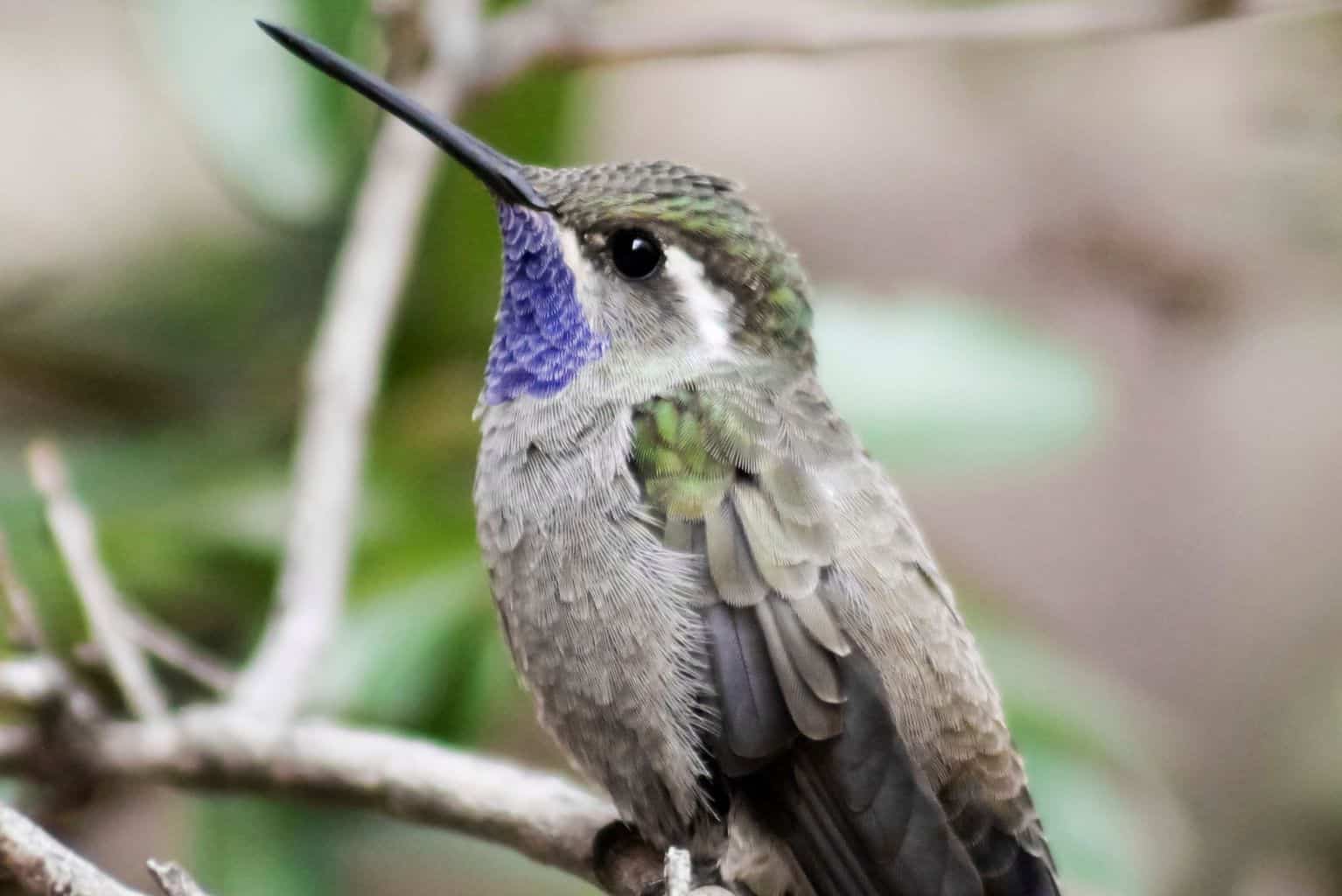
- Scientific Name: Lampornis clemenciae
- Length: 4.5 – 4.9 inches
- Weight: 0.3 oz
- Wingspan: 7 inches
Description:
Males have blue throat feathers, also called a gorget, and two distinctive white eye stripes: one behind the eye, and the other below it. The female hummingbird also has white eye stripes but does not have a blue throat. They also have large, white spots on their central tail feathers which can be spotted from a distance when they fly.
Additional Information:
Though named for their stunning blue throats, many birdwatchers spot them by their distinctive white tail feathers in flight, which appear like a flash in an instant.
Seriously, you can’t miss this them! Blue-throated Mountain-gems are large, loud and aggressive hummingbirds who make their presence known when they visit nectar feeders.
They are the largest hummingbirds that breed in North America, but you will only find them in the canyons of Southeastern parts of Arizona such as the Madera Canyon, Miller Canyon, Cave Creek Canyon, and Oak Creek Canyon. Their range maps a limited area, but stay close to flowing water, especially in spring and summer if you want to see one’s nest.
Fun Fact: These feisty little birds are assertive and work together when they are threatened. They have been known to cooperatively mob large predatory birds to drive them away.
Lucifer Hummingbird

- Scientific Name: Calothorax lucifer
- Length: 3.9 inches
- Weight: 0.11
- Wingspan: 4 inches
Description:
Male Lucifer Hummingbirds have vivid, deep purple feathers on their throats (gorget). While female birds are less colorful, both sexes have a green body tone.
Additional Information:
To identify a Lucifer Hummingbird, look out for its curved bill and forked tail, although it can be tricky to see unless they are in flight.
The tail of the Lucifer Hummingbird is so deeply forked that they are often called Lucifer Sheartails. When perched, this bird’s head appears to be too big for its tiny body, and it sometimes seems like it may overbalance.
Lucifer Hummingbirds can only be found in a few dry areas in southern Arizona. If you want to see one of these purple throated gems, your best chance would be in a location that has flowering agaves. While this hummingbird will frequent nectar feeders, they are often chased off by more dominant species of hummingbird.
Not So Fun Fact: These gorgeous little birds were popular in the 19th century as stuffed exhibits or kept as live caged birds. Thank goodness, times have changed!
Ruby-throated Hummingbird

- Scientific Name: Archilochus colubris
- Length: 3 — 4 inches
- Weight: 0.10 -0.14 oz
- Wingspan: 3 – 4 inches
Description:
Both sexes have either bright green feathers or golden-green feathers. Males have bright, iridescent red throats. Females, however, have a white throat and maintain that color elsewhere on their undersides.
Additional Information:
The Ruby-throated Hummingbird is a common species in many states across the Eastern United States.
However, Ruby-throated Hummingbirds aren’t frequent visitors to Arizona. Occasional sightings have been confirmed in southern Arizona, but there is no guarantee that you will see one in this state.
If you do, though, you’ll notice that they flit almost magically from one nectar source to the next, preferring tubular flowers, much like the average hummingbird. In areas where they are abundant, they can form impressive gatherings around a feeding station.
Fun Fact: The Ruby-throated hummingbird has extremely short legs, so it often appears to have no feet when perching. When on the ground, they shuffle along.
Black-chinned Hummingbird

- Scientific Name: Archilochus alexandri
- Length: 3.25 inches
- Weight: 0.1 – 0.2 oz
- Wingspan: 4.3 inches
Description:
Both male and female Black-chinned Hummingbirds have green backs and black, straight bills. The male has a prominent black crown accentuated by a band of white feathers immediately below his black chin. There is also a tinge of purple around their black band, but that is often difficult to see.
Females are pale-colored but have three broad white tips on their dark tail feathers.
Additional Information:
If you are birdwatching in Arizona during the spring and summer months, you will almost certainly see a Black-chinned Hummingbird. These tiny dots are a common resident that arrives around April during their spring migration and heads back to Mexico in October to set up its wintering grounds.
Fun Fact: These birds are highly adaptable. In addition to natural areas, they will inhabit urban areas or even places that have recently been disturbed.
Anna’s Hummingbird
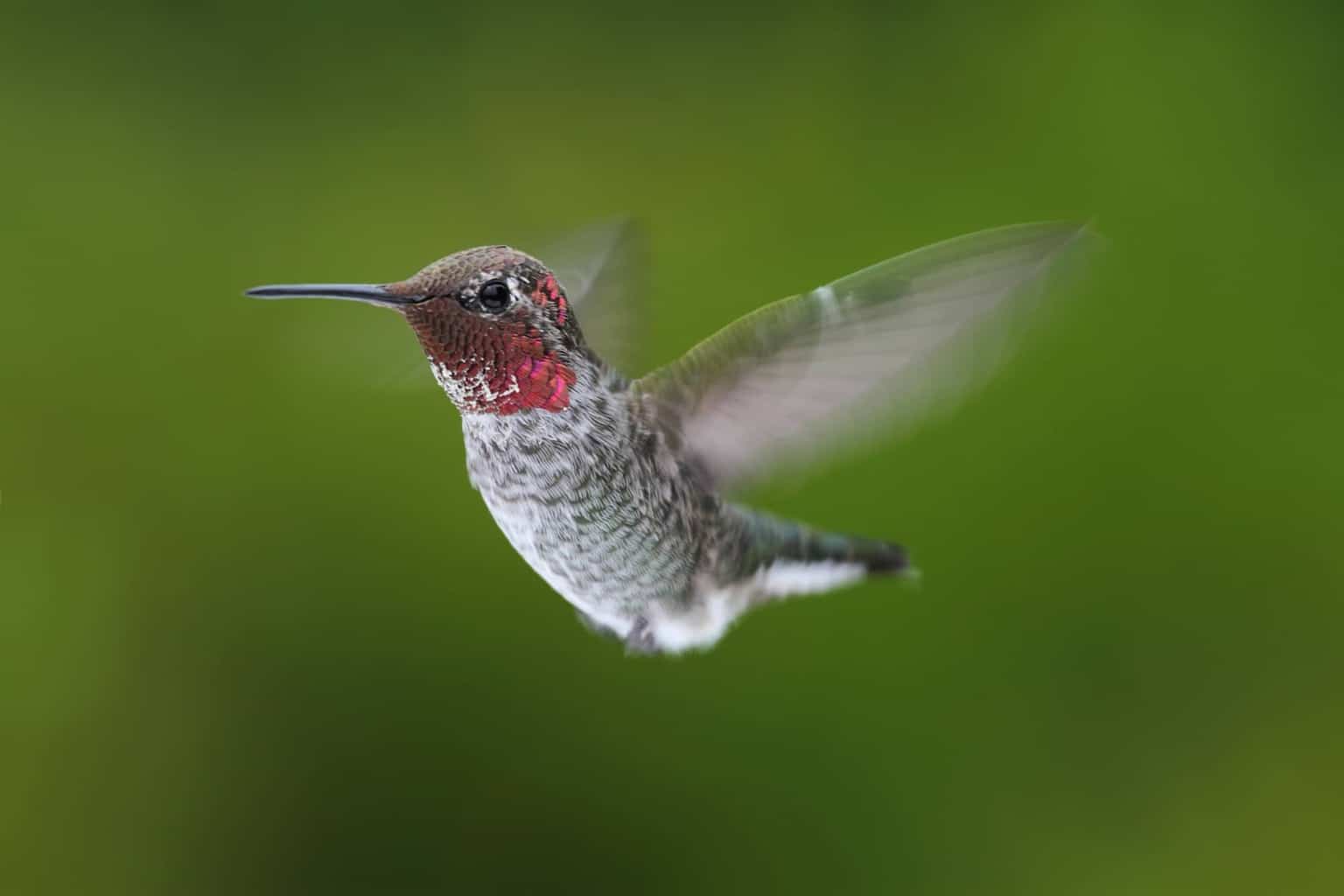
- Scientific Name: Calypte anna
- Length: 3.9 – 4.3 inches
- Weight: 0.1 – 0.2 oz
- Wingspan: 4.7 inches
Description:
Males have magenta throat feathers that contrast with the olive green feathers on their bodies and their gray-green crowns. Females have only a splash of color on their throats but have white-tipped outer tail feathers.
Additional Information:
Birdwatches of Arizona, look out for Anna’s Hummingbirds! They are often year-round residents in southern and central parts of the state and occur commonly in the southeastern mountain regions.
Anna’s hummingbird is one of the largest American hummingbird species, and they are non-migratory, permanent residents. Look for them in a tree nest or among dense shrubs searching for food and native plants to draw nectar from.
These medium-sized hummingbirds’ dark green feathers can look quite dull in low light, but they are showstoppers when the sun shines onto their iridescent shimmer.
Fun Fact: They are the only species of hummingbird that sings. The males produce sharp vocalizations as they move about, especially during the breeding season.
Costa’s Hummingbird

- Scientific Name: Calypte costae
- Length: 3 — 3.5 inches
- Weight: 0.07 — 0.11 oz
- Wingspan: 4.3 inches
Description:
Male Costa’s have vivid purple crowns and throats with metallic green backs. Females are gray-green with dark wings and white-tipped tails.
Additional Information:
In the western desert parts of Arizona, you can find Costa’s Hummingbirds throughout the year. Their southeastern counterparts often migrate during winter and arrive back in the state in February.
Costas hummingbirds thrive in desert areas, and their favorite nectar sources come from native plants like a flowering desert scrub.
These oddly shaped little birds appear hunched when they are perched. This is because their tails are incredibly short and therefore barely reach the end of their short wings. Their feathers tend to puff out along the sides, so Costa’s hummingbirds appear unassuming and compact while perching.
Fun Fact: Researchers have calculated that each Costas Hummingbird needs to visit 1840 flowers per day to fuel its super-high energy requirements.
Calliope Hummingbird

- Scientific Name: Selasphorus calliope
- Length: 2.8 – 3.9 inches
- Weight: 0.09 oz
- Wingspan: 4.3 inches
Description:
Males and females are brightly colored and have short, straight bills compared to the average hummingbird species. Males have magenta throat feathers, and both sexes have greenish backs.
Additional Information:
If you are hoping to see a Calliope Hummingbird in Arizona, your best chance would be to head up to the mountain range in the spring.
These rare little visitors arrive during their spring migration and leave before the start of fall. They migrate as far as British Columbia, Canada, and return later in the year to wintering grounds in Mexico.
Calliopes often search for nectar from flowers low to the ground, where they can hover and avoid larger species that might intimidate them.
Fun Fact: The Calliope hummingbird is the smallest bird in North America.
Rufous Hummingbird
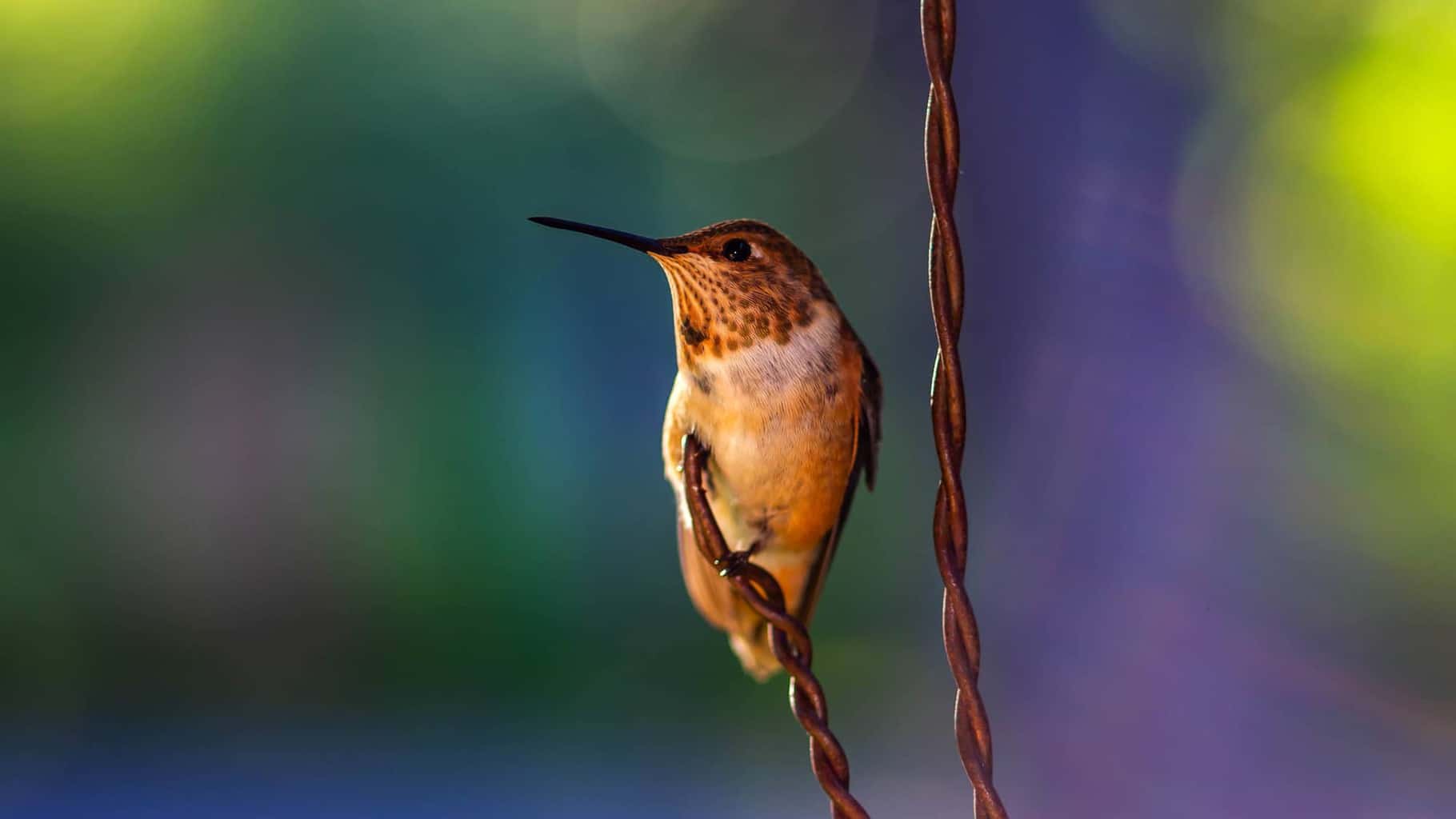
- Scientific Name: Selasphorus rufus
- Length: 2.8 — 3.5 inches
- Weight: 0.1 — 0.2 oz
- Wingspan: 4.3 inches
Description:
Males have iridescent orange feathers with an equally iridescent orange-red gorget. Females are pale emerald green with patches of orange on their throats. Rufous Hummingbirds are slender, straight-billed little birds with tails that taper to a point when folded.
Additional Information:
The Rufous Hummingbird makes its way through western parts of Arizona during the spring migration period. However, their numbers pick up during July and into mid-October, when you will be able to spot them throughout the state in large numbers.
Although Rufous Hummingbirds are only visitors, they make their presence known! They are feisty and will dominate garden feeders, often chasing away much larger birds.
Fun Fact: In bright sunlight, the male Rufous Hummingbird appears to glow like a hot ember.
Allen’s Hummingbird

- Scientific Name: Selasphorus sasin
- Length: 3.5 inches
- Weight: 0.1oz
- Wingspan: 4.3 inches
Description:
Both males and females have straight, black bills. Female Allen’s Hummingbirds are similar to males but without the bright copper-colored throat of the males. Instead, they have more of a mottled copper color around the throat.
Additional Information:
Allen’s Hummingbirds only occasionally occur in Arizona, and when they are in the state, it is most likely to be in July. Your best chance to see one of these little birds is in the extreme southeastern Patagonia region.
Fun Fact: This tiny hummingbird establishes its breeding habitat in a narrow strip of coastal scrubland extending from California to Oregon.
Broad-tailed Hummingbird

- Scientific Name: Selasphorus platycercus
- Length: 4 inches
- Weight: 0.1 – 0.14 oz
- Wingspan: 5.25 inches
Description:
Both sexes have big heads and straight bills, sporting iridescent green backs with a white patch on their chests. Males have a magenta throat while females have a green speckled throat.
Additional Information:
Broad-tailed Hummingbirds are sometimes called Mountain Hummingbirds because they prefer life in mountainous regions. These medium-sized hummingbirds arrive in southern Arizona in early spring and depart in late September.
Many people consider Broad-tailed Hummingbirds easy to find in part due to the uniquely large tails for which they’re named.
Fun Fact: When in flight, the wings of male Broad-tailed Hummingbirds create a loud metallic whirring sound.
Bumblebee Hummingbird
- Scientific Name: Selasphorus heloisa
- Length: 2.8 — 3 inches
- Weight: 0.069 oz
- Wingspan: 4 inches
Description:
The plumage of Bumblebee Hummingbirds is primarily green on top and white underneath. Males have an iridescent gorget which is a vivid violet-red. They are incredibly small birds with rounded tails and short straight bills.
Additional Information:
If you are birdwatching in Arizona and spot a Bumblebee Hummingbird, immediately take photos!
There have only been two specimens of this hummingbird species collected in the state, and that was all the way back in 1896. It is, therefore, not impossible that you might see one. But it is highly unlikely.
Your best chance of spotting a vagrant bumblebee hummingbird in Arizona would be in summer in the Huachuca and Chiricahua Mountains.
Fun Fact: These tiny bumblebee-sized birds are a wonder of nature. They are lighter than a penny.
Broad-billed Hummingbird
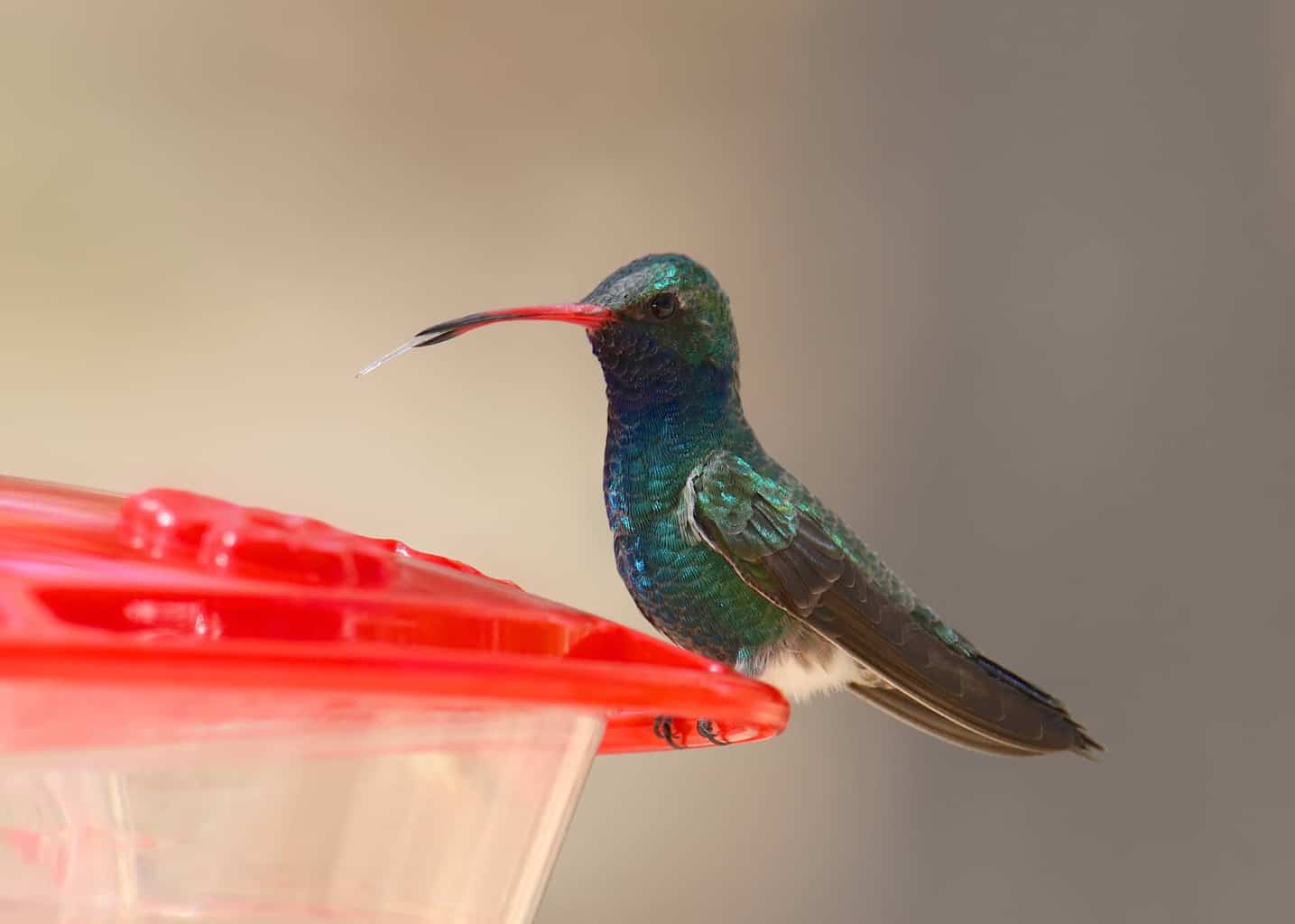
- Scientific Name: Cynanthus latirostris
- Length: 1 – 3.9 in
- Weight: 0.11oz
- Wingspan: 5.1 inches
Description:
Male Broad-billed Hummingbirds have eye-catching emerald dorsal feathers that shimmer vividly and contrast against their bright red bill. They have notched, full tails. Females have square tails and are far less colorful than males.
Additional Information:
Broad-billed Hummingbirds usually arrive in southeastern woodland areas of Arizona towards the end of March or early April and leave before winter comes, sometime around September. However, a few love the state so much that they call it home throughout the year!
Broad-billed Hummingbirds have long, straight bills that are perfect for slurping nectar from any available sources and will readily visit backyard birdfeeders.
Fun Fact: The intestine of this bird is about 2 inches long and as thin as human hair.
White-eared Hummingbird
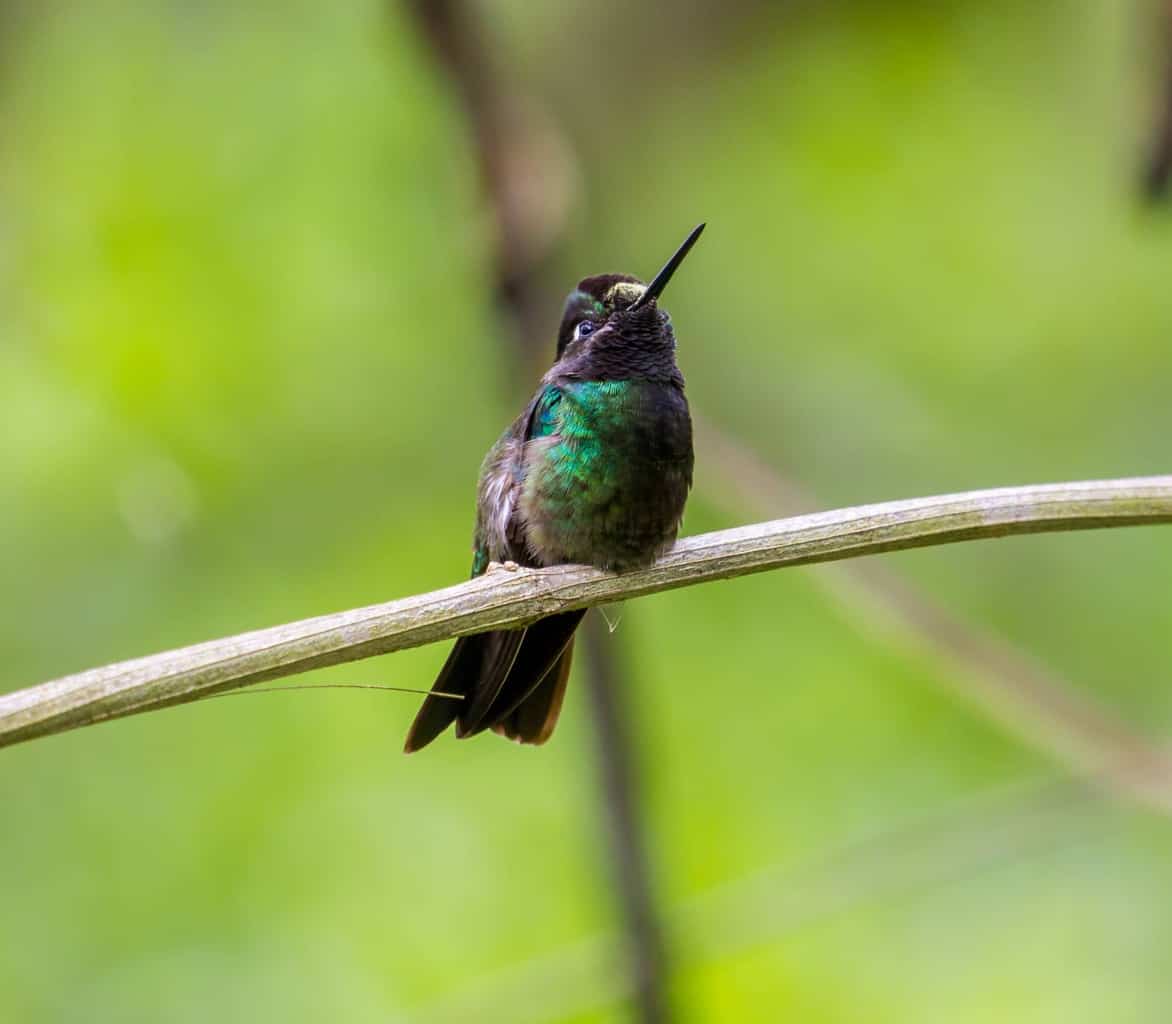
- Scientific Name: Basilinna leucotis
- Length: 3.75 inches
- Weight: 0.10 – 0.14 oz
- Wingspan: 5.75 inches
Description:
White-eared Hummingbirds are named for their ear patch markings, which look like a long white stripe behind the eye. Males and females also have distinctive orange, black-tipped bills. Adult males have a very bright, purple crown and throat, while female coloration is slightly less vivid.
Additional Information:
In Arizona, the best place to spot a rare White-eared Hummingbird is in the southeastern Huachuca Mountains between April and September. These gorgeous little birds are native to the mature forest woodlands of Mexican mountains but occasionally visit America, preferring to spend their time along forest edges.
Fun Fact: White-eared Hummingbirds establish exclusive feeding territories. Males will aggressively chase other males or even large insects like bumblebees that may stray into their territory.
Violet-crowned Hummingbird
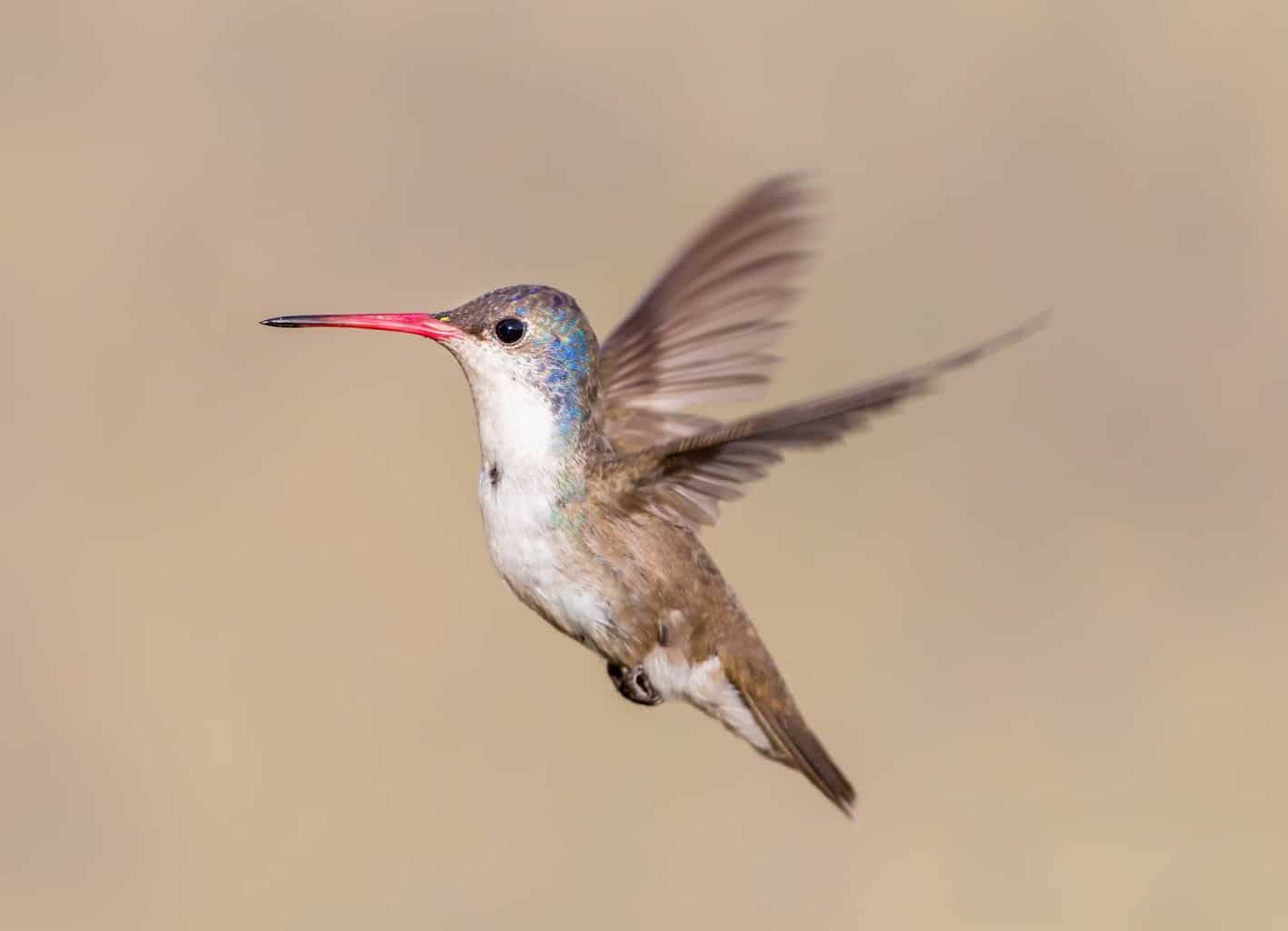
- Scientific Name: Leucolia violiceps
- Length: 3.9 inches
- Weight: 0.17oz
- Wingspan: 5.5 inches
Description:
Males and females have emerald dorsal feathers with a white throat and underside. They get their name from the purple feathers adorning their heads. Both males and females are similar in appearance, and have long, orange bills with black tips.
Additional Information:
Although the Violet-crowned Hummingbird is not common in Arizona, you might be able to spot it throughout the year if you know the right place to look: the Madrean Sky Islands in the southeastern region of the state.
Violet-crowned hummingbirds are also sometimes called Salvin’s Hummingbirds.
Fun Fact: Unlike all other species of hummingbirds in America, the Violet-crowned Hummingbird does not have a brightly colored gorget.
Berylline Hummingbird
- Scientific Name: Saucerottia beryllina
- Length: 3 — 4.25 inches
- Weight: 0.14 — 0.18 oz
- Wingspan: 5.25 inches
Description:
Male and female Berylline hummingbirds are almost identical. They have distinctive bright turquoise upper bodies contrasting their red wings and gray tail feathers. Their long, thin bills are black on top and orange on the bottom.
Additional Information:
The Berylline Hummingbird is rarely seen in Arizona, but a few individuals have been spotted regularly in the southeastern mountain region during the summer months.
Fun Fact: The Berylline Hummingbird is a prized sighting for birders visiting Arizona. It is one of the rarest hummingbirds found in the state.
Cinnamon Hummingbird

- Scientific Name: Amazilia rutila
- Length: 3.9 inches
- Weight: 0.18 oz
- Wingspan: 5.5 inches
Description:
Cinnamon Hummingbirds have a bronze-green upper and cinnamon lower section. Its square tail has a gold and green edging, and its beak is slightly down-curved with a black tip. Males and females are nearly identical.
Additional Information:
The occurrence of Cinnamon Hummingbirds in Arizona is listed as “extremely rare and accidental.” There has only ever been one recorded sighting of this species in this state during the summer in southern Arizona, so if you spot one, consider yourself extremely lucky.
Fun Fact: Male Cinnamon Hummingbirds mate with several females but do not assist in helping to nest or raise the juveniles.
Conclusion
Arizona is awash with birds of every variety, including 18 types of hummingbirds. Most of these tiny birds are found in the extreme southern parts of the state.
Many species of hummingbirds use Arizona as a stop-off on their annual migration to the northern regions. No visit to Arizona is complete without spending some time birdwatching and seeing how many types of tiny hummingbirds you can identify.

